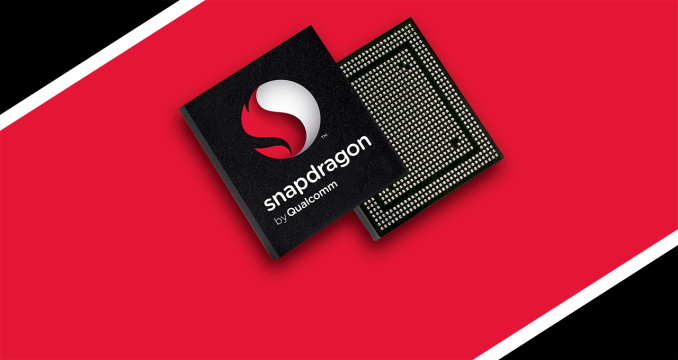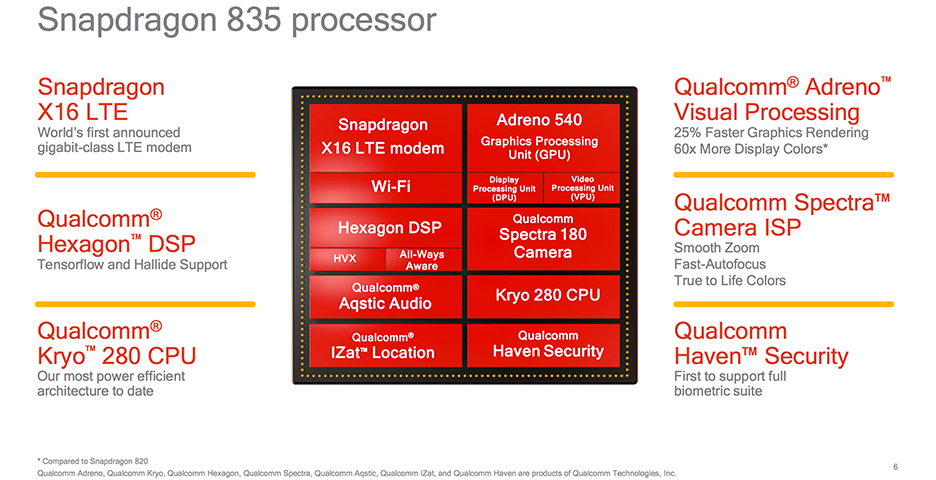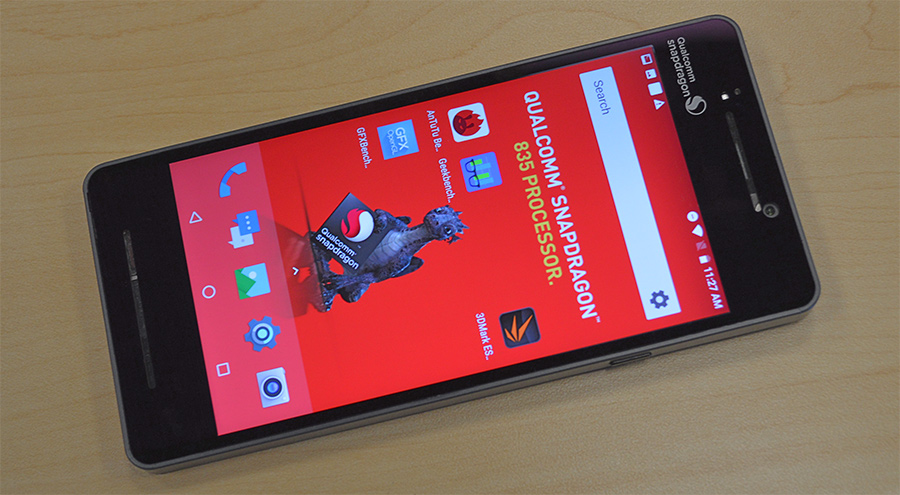The Qualcomm Snapdragon 835 Performance Preview
by Matt Humrick & Ryan Smith on March 22, 2017 4:30 AM EST- Posted in
- Smartphones
- Snapdragon
- Qualcomm
- Mobile
- SoCs
- Snapdragon 835
- Kryo

The Snapdragon 820 SoC was a significant milestone on Qualcomm’s roadmap. It was a solid improvement over the 808/810, delivering higher performance and efficiency, and became a commercial success, finding its way into the majority of flagship phones last year. More importantly, it heralded Qualcomm’s vision for mobile devices: heterogeneous computing. This meant new hardware—a much improved Hexagon 680 DSP that added single instruction, multiple data (SIMD) Hexagon Vector Extensions (HVX); Qualcomm’s first fully-custom 64-bit CPU core, Kryo, which focused on improving floating-point IPC; and an updated Adreno GPU with strong ALU performance—for enabling new software technologies and user experiences—artificial intelligence for smarter personal assistants, machine learning for object recognition, computational photography for better image and video quality, and new AR/VR experiences.
Snapdragon 835—now a part of Qualcomm’s Snapdragon Mobile Platform that includes all of the company’s mobile hardware and software—is an evolutionary product that builds on this vision. The greater than 3 billion transistor SoC is the first to use Samsung’s 10nm "10LPE" FinFET process, which reduces overall package size by 35% relative to Snapdragon 820. The new SoC’s CPU transplant and X16 LTE modem, which tops out at 1Gbps (Category 16) on the downlink, are the biggest changes, but most of the other blocks within the SoC have received at least minor updates too. For detailed information about all the changes and new features, you can read our Snapdragon 835 launch article.
| Qualcomm Snapdragon SoCs: Three Generations | |||
| SoC | Snapdragon 835 (MSM8998) |
Snapdragon 820 / 821 (MSM8996 / MSM8996 Pro) |
Snapdragon 810 (MSM8994) |
| CPU | 4x Kryo 280 Performance @ 2.45GHz 4x Kryo 280 Efficiency @ 1.90GHz |
2x Kryo @ 2.15GHz / 2.34GHz 2x Kryo @ 1.59GHz / 2.19GHz |
4x Cortex-A57 @ 2.00GHz 4x Cortex-A53 @ 1.50GHz |
| GPU | Adreno 540 @ 710MHz ? | Adreno 530 @ 624MHz / 653MHz | Adreno 430 @ 630MHz |
| Memory | 2x 32-bit @ 1866MHz LPDDR4x 29.9GB/s |
2x 32-bit @ 1866MHz LPDDR4 29.9GB/s |
2x 32-bit @ 1600MHz LPDDR4 25.6GB/s |
| ISP/Camera | Dual 14-bit Spectra 180 ISP 1x 32MP or 2x 16MP |
Dual 14-bit Spectra ISP 1x 25MP or 2x 13MP |
Dual 14-bit ISP 1x 21MP |
| Encode/Decode | 2160p30 (2160p60 decode), 1080p120 H.264 & H.265 |
2160p30 (2160p60 decode), 1080p120 H.264 & H.265 |
2160p30 (2160p60 decode), 1080p120 H.264 & H.265 |
| Integrated Modem | Snapdragon X16 LTE (Category 16/13) DL = 1000Mbps 3x20MHz CA, 256-QAM UL = 150Mbps 2x20MHz CA, 64-QAM |
Snapdragon X12 LTE (Category 12/13) DL = 600Mbps 3x20MHz CA, 256-QAM UL = 150Mbps 2x20MHz CA, 64-QAM |
Snapdragon X10 LTE (Category 9) DL = 450Mbps 3x20MHz CA, 64-QAM UL = 50Mbps 1x20MHz CA, 16-QAM |
| Mfc. Process | 10nm LPE | 14nm LPP | 20nm SoC |
In what has become an annual tradition going all the way back to Snapdragon 800, Qualcomm invited the media to its headquarters in San Diego for some feature demonstrations and limited testing using the company's Mobile Development Platform (MDP) devices. These are fully functional tablets or smartphones in a slightly oversized, utilitarian chassis used for hardware testing and software development. The MDP for Snapdragon 810 took the form of a tablet, while Snapdragon 820 came inside a large smartphone with a 6.2-inch display. This downsizing trend continues for Snapdragon 835, whose MDP/S is a smartphone with 6GB of RAM, a 5.5-inch 2560x1440 display, and a small 2850 mAh battery. The use of a smaller chassis is encouraging, because it has less mass and surface area to absorb and dissipate heat. This suggests a lower TDP for the 835, but we'll need to measure power consumption to be sure.
Because we only had a limited time for testing, we focused on running some basic CPU, GPU, and memory performance tests. Keep in mind that we were testing prototype hardware running pre-production software that resulted in a few hiccups. The condensed testing period also forced us to stray slightly from our usual testing methodology. Therefore, these numbers should be viewed as preliminary and could change by the time retail units begin shipping.












128 Comments
View All Comments
zeeBomb - Wednesday, March 22, 2017 - link
Its that time of year again!name99 - Wednesday, March 22, 2017 - link
"The [3DMark] Physics test runs on the CPU and is heavily influenced by how well an SoC’s memory controllers handle random access patterns. "No it isn't, at least not to an extent that matters in any modern CPU. Why do you keep posting this rubbish in review after review?
The source code is available for examination. It basically tests (frequency)*(number of cores) and is useless for learning anything beyond that. That's why it's always the only test in which Apple looks bad --- because Apple's running two cores as opposed to 4/6/8/10 on Android, and, at least in the past, those cores were under-clocked relative to the Android cores.
If people want to post the 3DMark Physics numbers, whatever, I don't care. But I do think doing so is a waste of reviewers' and readers' time --- there is simply no useful additional information provided by that benchmark.
The fact that 3DMark continues to push it (as opposed to the way GeekBench every year or two tries to respond to complaints and concerns about its benchmarks) tell you something about the relative professionalism of the two companies.
Matt Humrick - Wednesday, March 22, 2017 - link
"It basically tests (frequency)*(number of cores)"Both of these are factors, but it's not the whole story according to the developer I spoke with at Futuremark. If you have additional information to prove your claim, please share it with me via email. My mind is always open :)
name99 - Thursday, March 23, 2017 - link
I looked into this in detail years ago when there was a big kerfuffle about the iPhone 5S score.I'm not interested in spending another day doing the exact same thing. I'll just point out that what I am saying matches the data.
Sure, I'm not saying that THE ONLY THING is (frequency)*(number of cores), there's some small 5 to 10% variation around that; but that variation is unimportant --- the big picture is embedded in what I said.
Now, does this mean it's a good benchmark? Well, how much code that people care about is multi-threaded (on Android and otherwise)?
I'm not interested in relitigating that (given what I consider to be the astonishing incompetence and ignorance we saw on Anandtech the last time this was discussed, with a VAST proportion of readers apparently unaware of such concepts as timesharing, or how to accurately calculate the thread level parallelism of an executing piece of code).
I will say that the most recent academic papers I've read, dated 2016, referring to work in around 2014, show that it's higher than you might expect, not as high as you might hope. Across a very wide range of Android apps the thread level parallelism is slightly larger than 2, showing, basically (in my interpretation)
- an Android controlled thread doing misc stuff that's pretty busy
- a main app thread
- various small completion routines, async routines, and interrupts
So basically two cores get you almost all the value in real world core, a third core occasionally picks up a small amount of extra available work.
Now read what I am saying before getting upset. I'm NOT saying that ARM is stupid to ship 4 (performance) cores. ARM cores are tiny, they can be of (very occasional) value to a few talented developers today, and the only way we'll EVER get the mass market to code more parallel is to have the hardware out there as the default. So I'm happy that ARM is flooding the world with hexacore, octacore, decacore chips. (And I think Apple is being penny-wise and pound-foolish by not making every SoC they ship a triple core ala A8X --- the extra area would be small, and it would likewise provide an incentive for developers to get off their asses.)
But that's a different argument from whether core-count provides "visible performance" today.
I think the answer to that is clearly no. The first thing that matters to most users is snappiness (which depends, primarily, on flash performance, GPU [and the quality of the graphics code], performance governor (so does the CPU "start off" fast or "start off" slow and only get fast after .2 seconds of UI interaction? Then there are a few places where overall "endurance" performance matters (like much browser stuff, or viewing complicated PDFs --- both of which are very poorly threaded even as of 2017). Finally the cases where all cores all the time matters, and almost nothing else (the sort of thing 3DMark Physics is testing) are REALLY few and far between.
Or to put it another way. Most CPU microarchitecture improvement since 2000 has been about discovering and exploiting the stochastic structure of REAL-WORLD computation. There are re-uses and patterns in branching, in memory access, in instruction execution that are exploited ever more aggressively in branch prediction, in cache insertion and liveness tracking, in prefetching, in loop buffers, etc. A benchmark that prides itself on randomness and in providing no way for all those smarts to add value is saying SOMETHING about the worst case performance of a CPU, but it's not clear that that something is of any value to almost everyone.
Frenetic Pony - Wednesday, March 22, 2017 - link
How disappointing that yet another of the very few custom CPU designers is now gone. Looking at the general performance of the CPU now, I see no reason whatsoever to choose Qualcomm over some other, generic ARM hawker that's probably cheaper. They could at least stop pretending and just become a module seller, selling their GPU/modems/etc. separately as there doesn't seem to be any reason to choose a Qualcomm SOC as a whole.Other than ditching their stock (if you haven't already) none of this looks good for Qualcomm. Or for ARM for that matter, the A73 doesn't offer any performance boost over the A72 and is still trounced by Apple. Maybe the rumors of Google building its own CPU will come true and we'll see it in the Pixel 2.
serendip - Wednesday, March 22, 2017 - link
No reason? They're one of the few developer and open source friendly chip manufacturers around, even if that relationship ventures into frenemy territory once in a while. Qualcomm modems and imaging blocks are pretty good too.Intel are developer friendly but their GPUs can be an abomination to work with. They've also effectively abandoned the mobile space. Mediatek, Huawei and Samsung either give a cold shoulder or a middle finger to devs.
StrangerGuy - Thursday, March 23, 2017 - link
They dropped their own custom cores because why even bother when vanilla ARM does a better job while being cheaper...Plus the economics for a non-Apple, non-Samsung bleeding edge SoC no longer makes much sense, and 99.99% of the population buying these phones doesn't and won't give a shit to the SoC or the benchmarks.Meteor2 - Thursday, March 23, 2017 - link
It wouldn't surprise me if Qualcomm had multiple core design teams competing with each other. We've seen ARM cores come before; maybe full-custom will come back next year.SyukriLajin - Thursday, March 30, 2017 - link
I think they are just shifting their focus. The fact that they "rebranded" the snapdragon as a platform instead of just processor is one indicator. SOC is more than just cpu cores and they want people to know that. My guess is, they think that investing more money to develop a more unique platform is more important than spending valuable time and money on redoing the cpu core, ARM already invested a tons of money to develop it, no reason to reinvent the wheel when you can use the resources to provide a platform that will help them be more different then the others. I think it's wise for them. The resources would better off be spent to create a better DSP, modem, GPU etc, which will give them more return than a custom cpu core.MrPhilo - Wednesday, March 22, 2017 - link
So the Exynos 8895 GPU should in theory be faster than the 540 by quite a bit? Since the Huawei 9 uses 8, whereas Exynos uses 20, but of course with a lower clockspeed. I can see it being at least 20-30% faster than the 540.